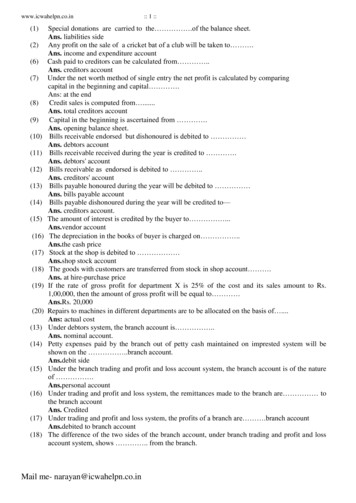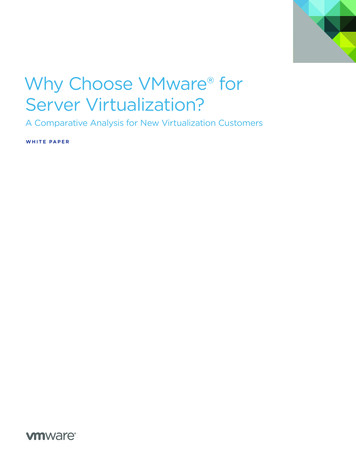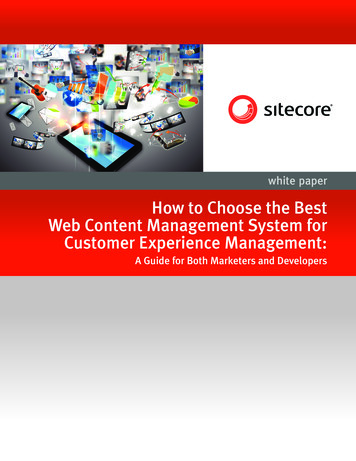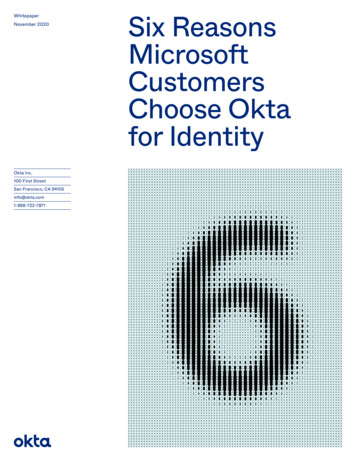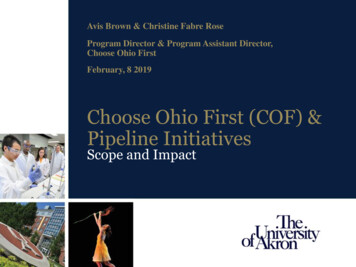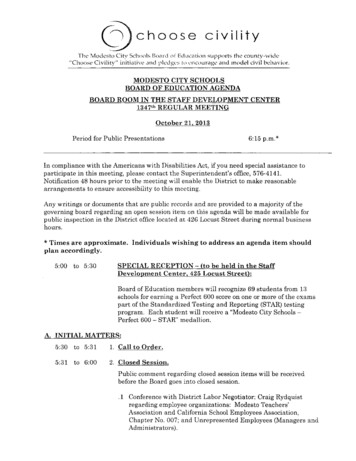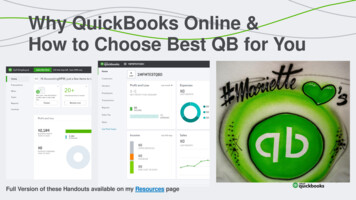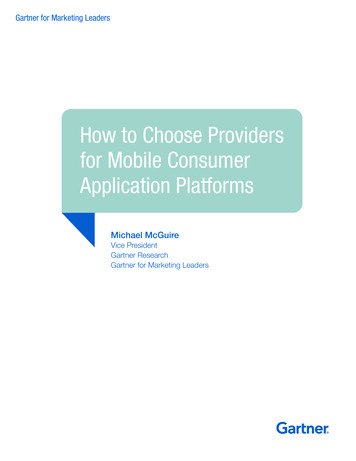
Transcription
Gartner for Marketing LeadersHow to Choose Providersfor Mobile ConsumerApplication PlatformsMichael McGuireVice PresidentGartner ResearchGartner for Marketing Leaders
Lead AuthorMichael McGuireVice President, Gartner Research, Gartner for Marketing LeadersMike McGuire guides digital marketers on best practices for developing strategies. He specializesin how context, community, location and time — combined with a consumer’s purchase historyand purchase intent — are changing the relationship between consumers and brands.Mike’s focus includes online music and media distribution, DRM, copyright-related issues,publishing and how social networking technology can provide new strategic opportunities formedia companies. He covers topics such as the consumer adoption of online music servicesand emerging business models, and he identifies technologies that can be used to developnew business models or overhaul existing models.Top 5 Issues That I Help Clients Address: What are the best practices for developing a mobile marketing strategy? How should I change my marketing strategy as a result of adoption of connected devices? What are consumer (demographics, geographic, industry, etc.) attitudes and behaviorsaround marketing? How will consumer concerns around privacy and security affect mobile marketers’ strategiesand tactics? Which approaches work best to model and analyze mobile audiences, actions and dialogues?Additional AnalystsJennifer S. BeckVice President, Distinguished Analystand Gartner FellowGartner ResearchGartner for Marketing LeadersJulie HopkinsDirectorGartner ResearchGartner for Marketing LeadersRichard FoutsVice PresidentGartner ResearchGartner for Marketing LeadersLaura McLellanVice PresidentGartner ResearchGartner for Marketing LeadersAndrew FrankVice PresidentGartner ResearchGartner for Marketing LeadersAdam SarnerDirectorGartner ResearchGartner for Marketing LeadersBill GassmanDirectorGartner ResearchGartner for Marketing LeadersJake SorofmanDirectorGartner ResearchGartner for Marketing LeadersYvonne GenoveseManaging Vice PresidentGartner ResearchGartner for Marketing LeadersAllen WeinerVice PresidentGartner ResearchGartner for Marketing Leaders
G00238613How to Choose Providers for Mobile ConsumerApplication PlatformsPublished: 22 August 2012Analyst(s): Mike McGuireSoftware development platforms that deliver consumer-facing applicationson mobile devices are rapidly evolving. Mobile marketers who work withcreative developers can use these guidelines to evaluate HTML5-focused,messaging and native tools, and cross-platform tool vendors.AnalysisThe emergence of media tablets and the billions of mobile phones in use today are driving newbusiness opportunities for digital marketers. Gartner is forecasting that more than 2 billion mobilephones will be sold in 2016, with an installed base of 5 billion devices. We also forecast thatworldwide mobile connections will grow to 7.6 billion in 2016. Interest in mobile B2C-facingapplications will continue to outpace that of mobile enterprise application adoption, as well asapplication and Web development in general. Follow these guidelines when evaluating and selectingofferings and vendors for mobile consumer application platforms. Review our "Magic Quadrant forMobile Consumer Application Platforms" to learn about the strengths and cautions for vendors inthis space.Understand the Basic Approaches That Enterprises Are UsingWhile mobile marketers aren't likely to deal directly with mobile consumer application platforms,understanding their capabilities helps improve working relationships with developers within yourorganization, or with third-party developers. There's no single dominant way to deliver mobile B2Capplications and content, but enterprises are using these basic approaches: Messaging, such as short message service or multimedia message service businessesprimarily use messaging for outbound marketing campaigns, voting and query/responseapplications.The mobile Web, with a special emphasis on leveraging advances around the HTML5 standardto better reach across different devices/browsers and to provide improved browserexperiences. Compared with native application approaches, the mobile Web is best forinformational and lighter weight, forms-oriented types of applications.Native/rich applications provide, in most cases, the best overall user experience. They arewritten for target environments or using a mix of Web and native programming. Digitalmarketers need this approach for apps provisioned from app stores. Native apps are best forinteractive applications that need access to resources on the device, such as camera, location,compass, and accelerometer. As HTML5 matures, however, mobile marketers need to workwith developers to understand how to best transition to browser-based apps. Cross-platform (compilation) tools that generate native or rich Internet application code.Typically, these platforms employ tradeoffs in using the common functions across devices. Inmost cases, the applications do not take advantage of the full capabilities of the targets.Developers also don't need to use the native coding environment to "tweak" the application fornative look and feel. Enterprises often use these tools to bridge applications among multipleplatforms.Mobile marketers are likely to encounter organizations that use a mixture of these categories fordifferent mobile business purposes, often mixing platforms and architectures, to reach the targetaudiences. We expect integration among the short message service, Web and native deliverysystems to increase. Leading mobile consumer application vendors will offer ways to extend andintegrate user experiences across these approaches.Focus on Evaluating Cross-Platform ToolsDifferent mobile consumer application platform paradigms are options for many clients that may beconsidering, for example, a messaging or a Web solution for a mobile consumer applicationrequirement, or a combination of the two (or three). In some cases, companies can use vendorofferings in tandem to cover multiple requirements, such as in creating mobile Web apps and thencreating native shells. They can then stage them in apps stores where they'll be discovered.Interest in cross-platform approaches (such as cross-compilers and client-side runtime containersfor applications) is increasing, as is interest in the impact and future direction of HTML5. More andmore mobile enterprise application platform vendors are adding mobile consumer applicationplatform functionality. This shows the effect of Web programming and consumerization on mobileapplication development, and points toward convergence of these markets.Most toolsets for mobile application development remain incomplete. There are no market leadersin consumer mobile application platforms, because the large ecosystem players, such as Google,Apple, Research In Motion (RIM), Nokia and Microsoft, aren't positioning their application andsupport platforms to support other operating systems.Select Tools From Multiple VendorsThe vendors with platforms focused on Web or cross-compilation are still relatively small —typically well under 50 million in annual revenue — and are likely acquisition or merger targets.Most organizations will need to adopt multiple mobile application delivery tools, usually frommultiple vendors, to cover the range of platforms and delivery methods they seek. Your audienceand the reach you need applications to achieve will determine which tools and vendors you select.The requirements for leadership in this market will continue to track higher in 2012. Leaders need tooffer multiplatform, markup-language-based or cross-compilation approaches, as well as all threeoutputs:Page 2 of 5Gartner, Inc. G00238613
Messaging Web Rich/thick clientmobile operating systems, the user experience, the size of the addressable consumer audience,the relationship of the mobile platform to e-commerce or Web investments, and the cost ofconducting marketing, advertising, analytics, location-based services and customer care forsuch solutions.Several vendors have the potential to meet this criterion if they can scale their ecosystems or takeadvantage of technologies, especially HTML5 and advanced software testing techniques. This willenable them to provide developers with ways to offer value across the underlying technologyboundaries.Adopt Multiple Mobile Application ParadigmsMobile application development for customers remains a hot topic for consumer-facing enterprises,regardless of the industry. Mobile application development has always been a trade-off betweenquality of experience and breadth of audience. Native applications limited to a single platform and,in the worst case, a single model of device, albeit at a high cost, provide the best quality ofexperience.Technologies, such as short message service, achieve the widest audience. These technologies arepractically everywhere and low-cost, but provide poor-quality user experiences. This is one of thekey drivers forcing organizations to adopt multiple mobile application paradigms. Some key metricspoint to the need for a multichannel approach. View these trade-offs as a set of tactical decisions, but realize that subplatforms and theirunderlying components form the infrastructure for orchestrating mobile applications andexperiences for consumers. Use our "Magic Quadrant for Mobile Consumer Application Platforms" to select vendors thatcreate native and Web-based experiences on smartphones and tablets, and to understand theplatforms available for staging mobile Web-browser-based applications to consumers.Recommended ReadingSome documents may not be available as part of your current Gartner subscription."Magic Quadrants and MarketScopes: How Gartner Evaluates Vendors Within a Market""Context-Aware Computing: The Importance of Mobile Consumer Application Platforms"Recognize the Dynamic Nature of This Emerging MarketThe market for mobile consumer application platforms is in its infancy. No provider has a completeplatform for all three types of mobile consumer application styles or all target platforms. At thispoint, market leaders are the providers that deliver a vision for what the market may become, butdon't automatically have all the technology components an enterprise may need.The future of this market is multiplatform. To remain a leader, providers will address devices andoperating systems that are not their own. No single device, provider, or operating system will have adominant market share in the long term. A major part of the provider selection task in this market isunderstanding and mapping the requirements to indicate what type of vendor you need.This market will change radically during the next five years, as leading tools support more platformsand more mobile application paradigms. The bar for leadership will rise significantly during the nextone to three years.What to Do Next Expect this market to shift from native to hybrid and Web approaches within three to five years.This will occur as technologies such as the mobile Web mature, browsers become increasinglyfunctional and capable of accessing device resources, and the toolsets provide richer features.Identify the relative strengths and weaknesses of mobile app developments with respect tomultiple factors. These factors should include portal and rich Internet application development,Gartner, Inc. G00238613Page 3 of 5Page 4 of 5Gartner, Inc. G00238613
Regional HeadquartersCorporate Headquarters56 Top Gallant RoadStamford, CT 06902-7700USA 1 203 964 0096Japan HeadquartersGartner Japan Ltd.Atago Green Hills MORI Tower 5F2-5-1 Atago, Minato-kuTokyo 105-6205JAPAN 81 3 6430 1800European HeadquartersTamesisThe GlantyEghamSurrey, TW20 9AWUNITED KINGDOM 44 1784 431611Latin America HeadquartersGartner do BrazilAv. das Nações Unidas, 125519 andar—World Trade Center04578-903—São Paulo SPBRAZIL 55 11 3443 1509Asia/Pacific HeadquartersGartner Australasia Pty. Ltd.Level 9, 141 Walker StreetNorth SydneyNew South Wales 2060AUSTRALIA 61 2 9459 4600 2012 Gartner, Inc. and/or its affiliates. All rights reserved. Gartner is a registered trademark of Gartner, Inc. or its affiliates. Thispublication may not be reproduced or distributed in any form without Gartner’s prior written permission. The information contained in thispublication has been obtained from sources believed to be reliable. Gartner disclaims all warranties as to the accuracy, completeness oradequacy of such information and shall have no liability for errors, omissions or inadequacies in such information. This publicationconsists of the opinions of Gartner’s research organization and should not be construed as statements of fact. The opinions expressedherein are subject to change without notice. Although Gartner research may include a discussion of related legal issues, Gartner does notprovide legal advice or services and its research should not be construed or used as such. Gartner is a public company, and itsshareholders may include firms and funds that have financial interests in entities covered in Gartner research. Gartner’s Board ofDirectors may include senior managers of these firms or funds. Gartner research is produced independently by its research organizationwithout input or influence from these firms, funds or their managers. For further information on the independence and integrity of Gartnerresearch, see “Guiding Principles on Independence and Objectivity” on its website, omb guide2.jsp.Gartner, Inc. G00238613Page 5 of 5
Why Gartner?Gartner helps companies improve their business results through the use oftechnology. Our independent research and advice is trusted by business andtechnology leaders in 13,000 organizations around the world.Our experienced research analysts talk to marketers every day — from thosejust entering the digital realm to the innovation trailblazers. These intera
Use our "Magic Quadrant for Mobile Consumer Application Platforms" to select vendors that create native and Web-based experiences on smartphones and tablets, and to understand the platforms available for staging mobile Web-browser-based applications to consumers. Recommended Reading
